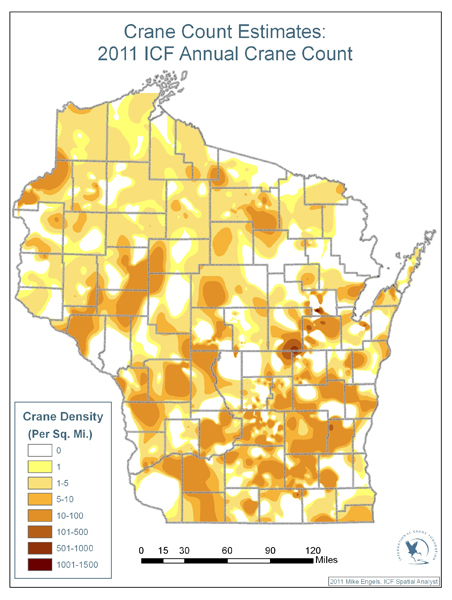Crane Count Results

View the 2025 results publication!
Although we have gathered data since 1976, the crane count did not expand to a large scale until 1981, and most of Wisconsin until 1985. Since the early 1980s, the crane count has grown to include over 120 counties in portions of six states in the upper Midwest (see History of the Crane Count for more details).
Each year, results are typically presented as a combined total, the total for each state, and the total for each participating county. If you are looking for or require more specific information, please contact us.
The Crane Count data provide an estimate of Sandhill Crane densities in Wisconsin and neighboring states. This map from the 2011 survey illustrates higher crane densities in dark brown and lower densities in gold and yellow.
Results Publications
History of the Crane Count
The 1976 Columbia County Crane Survey
In 1976, the Crane Count began as a survey in Columbia County, Wisconsin in search of Sandhill Cranes to identify the locations the cranes utilized, study their ecology, and later determine a better estimate of their population in the county. The initial survey involved less than two hundred volunteers.
The Sandhill Crane Survey
The next few years focused on improving and expanding the initial Columbia County Crane Survey by increasing involvement and covering a greater area. In 1978 the Crane Count grew to include five Wisconsin counties – Columbia, Sauk, Dane, Dodge and Jefferson.
The Annual Wisconsin Sandhill Crane Survey
In 1981, the International Crane Foundation and the Wisconsin Wetlands Association expanded the Crane Count into 34 counties. Procedures for holding the Crane Count were standardized – instead of taking place over a range of dates, the Crane Count took place on one designated day and time. The goals for expanding Crane Count were to enhance wetland protection (Wisconsin currently retains about half of its historic wetlands) by promoting awareness, documenting areas where cranes were known to occur and begin documenting the size of the crane population. 760 volunteers contributed to the effort.
The Annual Wisconsin Sandhill Crane Count
In 1982, the Crane Count expanded to 43 Wisconsin counties and covered the majority of the Sandhill Crane’s range in the state at that time. Between its near statewide scope and established consistency, Crane Count became more valuable as a tool to assess the abundance and distribution of Sandhill Cranes, and in the future, long-term trends. The number of volunteer participants more than doubled to 1,617.
In 1985, almost the entire state was covered, with 67 counties joining the effort. Over 2,000 volunteers counted more than 6,000 cranes. Crane Count was presented at the 1985 Crane Workshop as a project involving public participation. As Crane Count became established, its focus was on research, education, and wetland conservation.
The Annual Midwest Sandhill Crane Count
In 1994, Crane Count expanded from a statewide survey to the upper Midwest, involving Minnesota and Michigan. Illinois followed in 1995, and Iowa in 1996. As the crane population steadily expands into neighboring states, Crane Count still allows the International Crane Foundation to monitor the abundance, distribution, and dispersal of the eastern population of Sandhill Cranes. In 2000, participants counted a record total of over 13,500 Sandhill Cranes spread throughout portions of the five states. Crane Count continues to evolve with more than 100 counties participating each year. Currently, more than 2,500 volunteer counters participate each year.
The Annual Midwest Crane Count
In 2005, due to promising efforts by the Whooping Crane Eastern Partnership to reintroduce Whooping Cranes into Wisconsin, we renamed the Crane Count to include the endangered Whooping Cranes that now grace our Midwestern landscape.